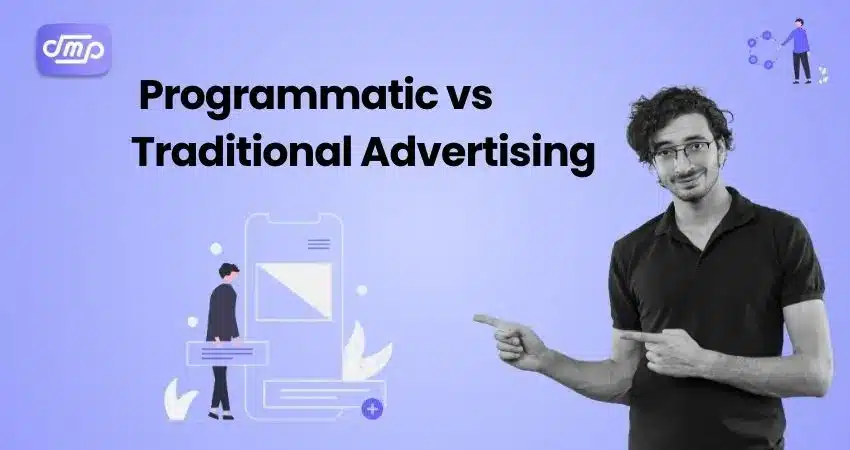
- July 2, 2024
- Digital Marketing
Table of Contents
Small businesses must make the crucial choice of how best to spend their advertising resources in the dynamic field of marketing. The debate between programmatic vs traditional advertising has gained more relevance than before due to the development of digital technologies.
The term “traditional advertising” refers to techniques that have been used for many years, including billboards, TV commercials, radio spots, and print advertisements. These tried-and-true methods have worked well for building brand awareness and reaching large audiences. But they frequently have more expensive prices and less accurate targeting. Accurately determining the success of traditional advertising can be difficult because it depends on fixed schedules and a wide range of demographic information.
On the other hand, programmatic advertising is the state-of-the-art in digital marketing. This approach makes use of algorithms and automated technology. Programmatic advertising offers a number of benefits, such as cost-effectiveness, real-time data analysis, and the ability to modify campaigns on the fly based on performance metrics. This level of customization and flexibility is especially helpful for small businesses looking to maximize their advertising spend.
As small businesses navigate the complex landscape of modern marketing, understanding the strengths and limitations of both programmatic and traditional advertising is essential. This guide aims to provide a comprehensive comparison, helping small business owners make informed decisions about which strategy—or combination of strategies—best suits their particular needs and goals, advertising initiatives for small businesses are successful.
For small businesses, advertising is essential since it helps to ensure sustainability and spur growth.
- Brand Awareness: Small businesses can build and strengthen their brand recognition with the aid of advertising. Businesses may create a lasting impression on prospective clients by showcasing their brand frequently. This will help clients remember and select them in the future.
- Customer Acquisition and Retention: By educating potential consumers about the available goods and services, effective advertising draws in new clients. It also aids in keeping current clients interested and updated about new products, specials, or upgrades.
- Competitive Advantage: Advertising helps small firms stand out from the competition in a crowded market. showcasing advantages and special selling features in focused advertising might offer a tiny company an advantage over more established, bigger rivals.
- Sales and Revenue Growth: By contacting prospective clients who might not be aware of the company or its products, advertising increases sales. By transforming these leads into paying clients, small companies can boost sales and profits.
- Local Market Penetration: Local clients can be efficiently targeted by advertising for small firms, particularly those that cater to the local community. Local SEO, neighborhood gatherings, regional periodicals, and digital advertisements with geotargeting are some ways to do this.
- Establishing Credibility and Trust: Professional, consistent advertising contributes to the development of credibility and trust within the target market. Customers view a firm as stable, trustworthy, and reliable when they see consistent, high-quality marketing.
- Comments and Market Understanding: Marketing initiatives offer insightful information about consumer inclinations and actions. Small businesses can improve the effectiveness of their marketing tactics and better cater to the wants and preferences of their target audience by evaluating the efficacy of their ads and consumer responses.
- Increasing Online Traffic: In the current digital era, increasing online traffic to a company’s website or social media pages requires advertising. A stronger online presence has the potential to generate more inquiries, more interaction, and eventually more purchases.
Advertising is an essential instrument for small businesses to develop their brands, draw in and keep clients, obtain a competitive edge, boost sales, and learn important industry information. Small firms may find it difficult to realize their full potential and maintain growth in a cutthroat industry without efficient promotion.
Programmatic vs Traditional Advertising

Understanding the unique qualities, advantages, and difficulties of programmatic vs traditional advertising is necessary to make an informed decision. Below, we contrast these two strategies based on a number of important variables:
Efficacy and Cost of Programmatic Advertising
- Dynamic Pricing: Makes use of real-time bidding (RTB) to buy advertising space, enabling competitive pricing and flexible budgets.
- Lower Costs: Usually more economical because of more accurate targeting and less waste.
- Efficiency: Time and resources are saved when operations are automated because they require less intensive manual intervention.
Efficacy and Cost of Traditional Advertising
- Fixed pricing: Usually refers to more expensive and inflexible expenses, such as predetermined prices for print or TV advertisements.
- Broad Reach: Although it has the ability to reach a large audience, it frequently leads to higher spending with less precise targeting.
- Resource-intensive: Needs a substantial amount of involves a lot of manual labor for placement, negotiation, and planning.
Reach and Targeting in Programmatic Advertising
- Targeting particular behaviors, hobbies, and demographics through the use of data and algorithms is known as precise targeting.
- By adjusting ads to each person individually, you may raise engagement and relevancy.
- Campaigns that are easily scalable can target hyper-local or global audiences as needed.
Reach and Targeting in Traditional Advertising
- Useful for using mass media outlets to effectively reach huge, general audiences.
- Limited capacity to focus on niches other than the most basic demographics.
- Print and television are two well-known and reliable media that can increase brand credibility.
Adaptability and Effectiveness in Programmatic Advertising
- Real-Time Adjustments: Enables changes to be made quickly in response to performance indicators.
- Automated buying: Shortens lead times and streamlines the ad buying process through automation.
- Campaign Optimization: Ongoing, data-driven optimization Over time, data insights enhance ad performance.
Adaptability and Effectiveness in Traditional Advertising
- Fixed Schedules: Ad placements are frequently scheduled in advance and have set schedules, which reduces flexibility.
- Longer Lead Times: The phases of planning and execution may take a while and be less flexible.
- Consistency: Delivers messages consistently through reputable media outlets, but isn’t very responsive in real time.
Analytics and Measurability of Programmatic Advertising
- Detailed Analytics: Provides comprehensive information on user interactions, ROI, and ad performance.
- Real-Time Data: Having access to data in real time enables prompt analysis and strategy modifications.
Analytics and Measurability of Traditional Advertising
- Basic measures: Depends on more general, sometimes imprecise measures like frequency and reach.
- Delayed Feedback: It might be challenging to assess the immediate impact of performance data since it is frequently less detailed and delayed.
The precise objectives, target market, and financial limitations of a small firm all influence the decision between programmatic vs traditional advertising. For companies searching for customized, data-driven campaigns, programmatic advertising is the best option since it provides accuracy, cost-effectiveness, and real-time adaptability.
Factors Small Businesses Should Consider When Choosing an Advertising Strategy

For small businesses hoping to reach their objectives and make the most out of their marketing budget, choosing the appropriate advertising plan is essential. When choosing between programmatic vs traditional advertising, or a hybrid approach, keep the following points in mind:
- Evaluate how cost-effective each advertising strategy is, because programmatic advertising uses precise targeting and automated bidding, it usually results in cheaper costs and improved efficiency. Because the cost of advertising space in traditional media—such as radio, print, and television—is set, it frequently demands a higher budget.
- ROI, or return on investment, Determine each method’s possible return on investment. Due to comprehensive analytics, programmatic advertising provides more accurate tracking of ad spend and ROI; traditional advertising, on the other hand, may provide less accurate measurement but can result in great visibility and as well as brand awareness.
- Determine the characteristics, hobbies, and habits of your target audience. Based on data insights, programmatic advertising is excellent at targeting particular audience segments. Although it may not be as targeted as modern advertising, traditional advertising nevertheless reaches a larger population.
- Take into account where your company is focused geographically. Conventional means such as local newspapers, radio, and community activities can work well if you have to target a local audience. Geo-targeting programmatic advertising is another way to precisely target particular regions.
- Traditional advertising may be helpful if increasing brand awareness is your main objective due to its broad audience. The exact targeting and real-time capabilities of programmatic advertising are ideal for direct response and conversion-focused campaigns.
- Establish how long your campaign will last. Long-term brand building is frequently better served by traditional advertising, while programmatic advertising enables short-term, highly focused programs that are flexible enough to be changed in real-time.
- Assess each programmatic vs traditional advertising method’s capacity for measurement. Data-driven decision-making is made possible by programmatic advertising, which offers comprehensive analytics and real-time tracking of performance measures. Conventional advertising focuses heavily on surveys and estimates and provides fewer metrics.
- Make the most of the data at your disposal to improve your programmatic vs traditional advertising. Programmatic advertising’s use of big data and machine learning can continuously improve targeting and ad performance, whereas traditional advertising may offer limited data insights.
- Take into account the variety of ad types. Creative experimentation is enabled via programmatic advertising, which allows several forms such as display ads, video commercials, and native ads. Even if traditional advertising has more rigid formats, visually striking TV commercials and print ads can still have an impact.
- Evaluate how fast you can change your advertisements. While traditional advertising frequently necessitates lengthier lead times for modifications, programmatic advertising enables real-time adjustments based on performance data.
- Establish the desired level of participation. Users’ experiences can be tailored and engaging using programmatic advertising, increasing user engagement. Traditional advertising typically offers one-way communication but can still be powerful through memorable, high-quality creative content.
- Plan how to integrate your programmatic vs traditional advertising across multiple Make a plan for integrating your advertising across several media. Combining the benefits of both approaches, a hybrid strategy uses programmatic advertising to increase targeted engagement and conversions while traditional advertising builds brand awareness and reaches a wider audience.
- Examine the marketing tactics used by rival businesses in your sector. Your decision-making process can be aided by knowing what has worked for companies in a similar situation. If rivals are making significant programmatic investments, this could point to a shift in the direction of digital efficacy.
- Think about how many channels there are for programmatic vs traditional advertising. If there are many rivals in traditional media, programmatic advertising may provide a less congested way to reach your target demographic.
Conclusion
Small businesses can make well-informed judgments about their advertising tactics by carefully weighing these elements. By striking a balance between the benefits and drawbacks of programmatic vs traditional advertising, a customized strategy that achieves particular company goals optimizes budget efficiency, and successfully reaches the target audience may be implemented.












